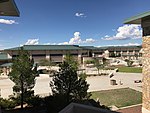Hadley-Ludwick House
1907 establishments in New Mexico TerritoryColonial Revival architecture in New MexicoHouses completed in 1907National Register of Historic Places in Doña Ana County, New MexicoNew Mexico Registered Historic Place stubs ... and 1 more
Use mdy dates from August 2023

The Hadley-Ludwick House is a historic house in Las Cruces, New Mexico. It was built in 1907 for Hiram Hadley, the founder of Las Cruces College, later known as New Mexico State University. The house was designed in the Colonial Revival architectural style. It has been listed on the National Register of Historic Places since April 3, 1991.
Excerpt from the Wikipedia article Hadley-Ludwick House (License: CC BY-SA 3.0, Authors, Images).Hadley-Ludwick House
El Paseo Road, Las Cruces
Geographical coordinates (GPS) Address Nearby Places Show on map
Geographical coordinates (GPS)
| Latitude | Longitude |
|---|---|
| N 32.283055555556 ° | E -106.76166666667 ° |
Address
El Paseo Road
El Paseo Road
88001 Las Cruces
New Mexico, United States
Open on Google Maps








